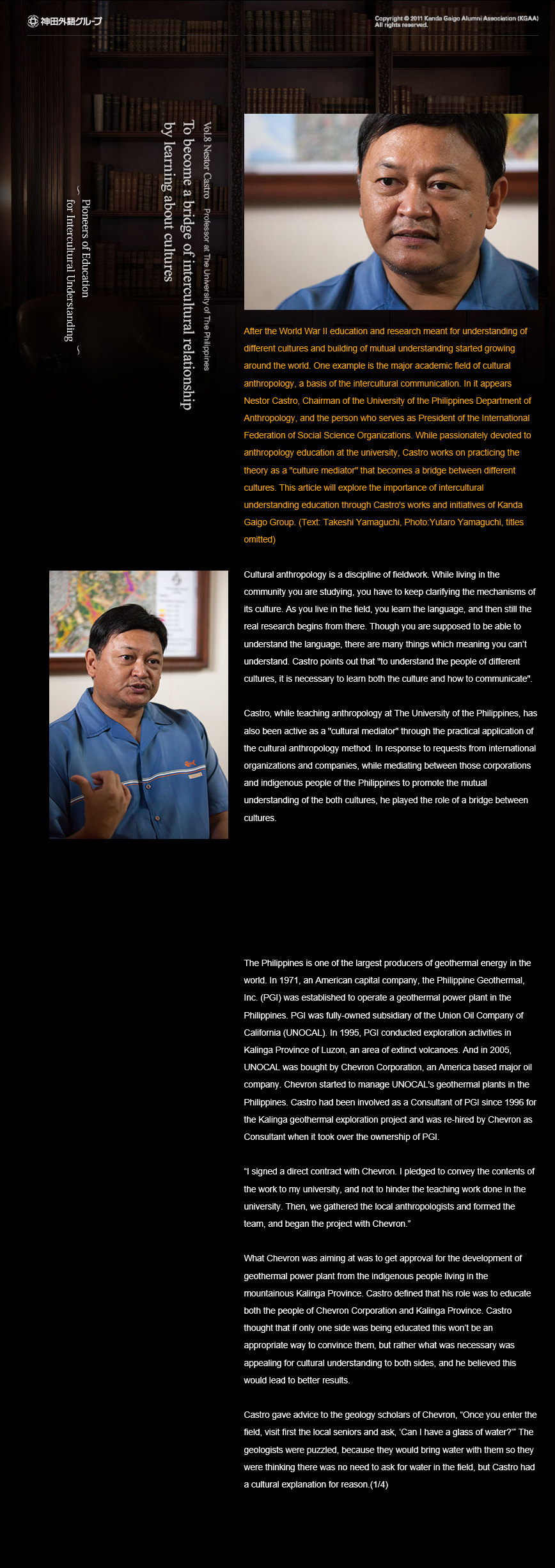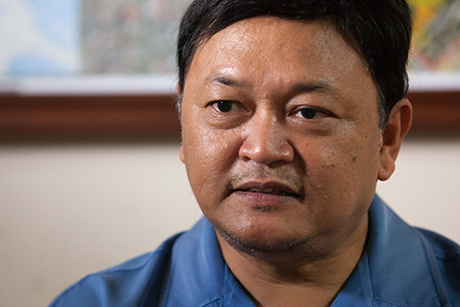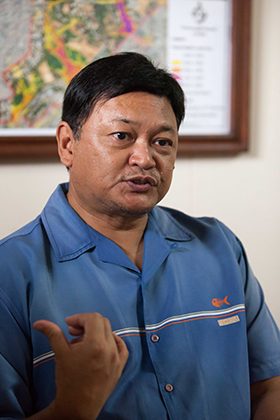

Copyright © 2011 Kanda Gaigo Alumni Association(KGAA). All rights reserved.

After the World War II education and research meant for understanding of different cultures and building of mutual understanding started growing around the world. One example is the major academic field of cultural anthropology, a basis of the intercultural communication. In it appears Nestor Castro, Chairman of the University of the Philippines Department of Anthropology, and the person who serves as President of the International Federation of Social Science Organizations. While passionately devoted to anthropology education at the university, Castro works on practicing the theory as a "culture mediator" that becomes a bridge between different cultures. This article will explore the importance of intercultural understanding education through Castro's works and initiatives of Kanda Gaigo Group. (Text: Takeshi Yamaguchi, Photo:Yutaro Yamaguchi, titles omitted)

Cultural anthropology is a discipline of fieldwork. While living in the community you are studying, you have to keep clarifying the mechanisms of its culture. As you live in the field, you learn the language, and then still the real research begins from there. Though you are supposed to be able to understand the language, there are many things which meaning you can’t understand. Castro points out that "to understand the people of different cultures, it is necessary to learn both the culture and how to communicate".
Castro, while teaching anthropology at The University of the Philippines, has also been active as a "cultural mediator" through the practical application of the cultural anthropology method. In response to requests from international organizations and companies, while mediating between those corporations and indigenous people of the Philippines to promote the mutual understanding of the both cultures, he played the role of a bridge between cultures.
The Philippines is one of the largest producers of geothermal energy in the world. In 1971, an American capital company, the Philippine Geothermal, Inc. (PGI) was established to operate a geothermal power plant in the Philippines. PGI was fully-owned subsidiary of the Union Oil Company of California (UNOCAL). In 1995, PGI conducted exploration activities in Kalinga Province of Luzon, an area of extinct volcanoes. And in 2005, UNOCAL was bought by Chevron Corporation, an America based major oil company. Chevron started to manage UNOCAL's geothermal plants in the Philippines. Castro had been involved as a Consultant of PGI since 1996 for the Kalinga geothermal exploration project and was re-hired by Chevron as Consultant when it took over the ownership of PGI.
“I signed a direct contract with Chevron. I pledged to convey the contents of the work to my university, and not to hinder the teaching work done in the university. Then, we gathered the local anthropologists and formed the team, and began the project with Chevron.”
What Chevron was aiming at was to get approval for the development of geothermal power plant from the indigenous people living in the mountainous Kalinga Province. Castro defined that his role was to educate both the people of Chevron Corporation and Kalinga Province. Castro thought that if only one side was being educated this won’t be an appropriate way to convince them, but rather what was necessary was appealing for cultural understanding to both sides, and he believed this would lead to better results.
Castro gave advice to the geology scholars of Chevron, “Once you enter the field, visit first the local seniors and ask, ‘Can I have a glass of water?’” The geologists were puzzled, because they would bring water with them so they were thinking there was no need to ask for water in the field, but Castro had a cultural explanation for reason.(1/4)